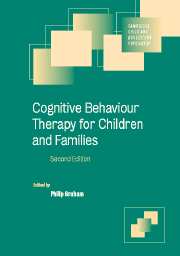Book contents
- Frontmatter
- Contents
- List of contributors
- 1 Introduction
- Part I Developmental cognitive theory and clinical practice
- Part II Engagement and assessment
- Part III Client groups
- Part IV Applications in psychosocial adversity
- 10 Cognitive behavioural treatment of the emotional and behavioural consequences of sexual abuse
- 11 Adjustment to parental separation and divorce
- Part V Applications in specific child and adolescent psychiatric disorders
- Part VI CBT applications in preventive interventions
- Index
- References
11 - Adjustment to parental separation and divorce
Published online by Cambridge University Press: 21 August 2009
- Frontmatter
- Contents
- List of contributors
- 1 Introduction
- Part I Developmental cognitive theory and clinical practice
- Part II Engagement and assessment
- Part III Client groups
- Part IV Applications in psychosocial adversity
- 10 Cognitive behavioural treatment of the emotional and behavioural consequences of sexual abuse
- 11 Adjustment to parental separation and divorce
- Part V Applications in specific child and adolescent psychiatric disorders
- Part VI CBT applications in preventive interventions
- Index
- References
Summary
Introduction
The terms ‘adjustment’, ‘separation’ and ‘divorce’ are not as straightforward as they might appear at first sight. Adjustment is a multidimensional concept and requires contextual and operational definitions to be clinically useful. Divorces are diverse in their manifestation, and multifactorial in their origins, pathways and outcomes. The adjustment of adults, children and adolescents to the impact of divorce and separation can be measured in various ways (e.g. Munsinger and Kaslow, 1996), as is the case with the rating of the acrimony accompanying the break-up (e.g. Kurdek, 1987; Emery, 1992). Adjustment may refer to adaptation to trauma, itself a matter of degree, in any or all of several domains: emotional, behavioural, cognitive or social. These reactions may be concurrent, brief in duration, long term or delayed (‘sleeper effects’). The adaptation required may not necessarily be to a life event perceived as traumatic, but rather to one experienced as a happy release from maltreatment (Browne and Herbert, 1997).
Increasingly, it is not a marriage that is ending in separation, but a cohabiting relationship that has failed. In the early 1960s, some 90% of children and teenagers were raised in homes with two married birth parents; today, the figures are around 59% in the UK and 40% in the USA. This marked reduction in numbers is due to the dramatic increase in divorces and separations.
- Type
- Chapter
- Information
- Cognitive Behaviour Therapy for Children and Families , pp. 170 - 184Publisher: Cambridge University PressPrint publication year: 2004



